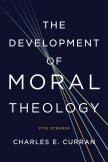Higher authorities
Religious freedom? We were against it before we were for it. The papacy at one time unreservedly condemned religious freedom as “madness,” but now U.S. bishops condemn any restrictions on it. Earning interest on a loan? The Vatican condemned this practice, then it allowed the idea, and subsequently it created its own bank. With the scandals surrounding the Vatican Bank and the too-big-to-fail-and-too-big-to-prosecute American banks, perhaps the Vatican might consider some form of return to the biblical prohibition of usury. Catholic moral teaching evolves.
Charles Curran regularly refers to changes like these in his most recent book. Currently the Elizabeth Scurlock University Professor of Human Values at Southern Methodist University in Dallas, Tex., Curran is author of over 37 books and editor of many more. This book is his witness to the developments in moral theology over the past six decades. Even when he delves deeply into the distant past, he does so in order to show how tradition has made moral theology distinctively Catholic. Although Curran suffered ostracism during this period, his writing is even-handed and for the most part reportorial.
Prior to the Second Vatican Council, most moral theology textbooks limited themselves to enumerating all the ways that humans could fail. The good news of Christianity was left to spiritual theology, which was considered less important and more suitable for nuns and monks. Moral manuals catalogued sins according to the Ten Commandments and graded them according to whether they deserved purgatory or hell.
Curran tries to rescue Catholic moral theology from being a slightly warmed-over version of moral philosophy. He wants to recover St. Thomas Aquinas’s claim that grace perfects nature. Nevertheless, he admits that Thomas’s own grounding of ethics in philosophy led the many subsequent Thomisms to slight the theological dimension of Christian ethics. When Pope Leo XIII in 1879 imposed Thomism on the church, the result was a “scientific” neoscholasticism that continued to neglect the religious riches of the Catholic tradition. Pre-Vatican II moral manuals focused deontologically on the rules that one must obey. Not Aquinas’s reasonableness, but Ockham’s submission of the will was central.
Curran is at pains to show that there are many contrasting theories and practices that go by the name natural law. One enduring version refers to what nature has established in all animals. As a consequence, masturbation is worse, sexually, than rape because it frustrates procreation, whereas the latter does not. Paul VI’s encyclical on birth control is an offspring of this type of natural law. Another enduring version of natural law insists that the natural is the reasonable, and thus rape is far worse. A very different and especially effective kind of natural law thinking, avers Curran, undergirds the social teaching of the church. For example, providing food for the hungry and health care to the sick are supported by the natural law.
Curran underscores the impact that a growing awareness of history has had on moral theology. For the classical tradition, moral norms, once established by the church, apply to all people in all situations and can never be changed. Historical consciousness challenges that assumption. This divergence prompted Cardinal Ratzinger/Pope Benedict XVI’s preoccupation with relativism. Similarly, a growing awareness of psychology and sociology shifted the stress from particular acts to, on the one hand, subjectivity and, on the other, inculturation. In response to these changes, several revisionist moral theologies arose after Vatican II, some to question official teaching and some to offer fresh defense of it.
Curran describes in detail how, for the practice of moral theology, few changes have been as significant as the shift in the role of the papacy. In the first millennium, popes functioned mainly as local and regional leaders. They did not “rule” the church nor define doctrines. But in the second millennium, the papacy assumed ever more power. Whereas earlier the local bishop and theologians took up pressing moral problems, increasingly Rome set up the expectation that it could and should decide all moral questions. The church became papalized. Being a Catholic came to mean obeying the pope.
Once teaching authority became centralized in the Vatican, the criterion of truth became the authority of the pope who proposed it, not its evidence or fruitfulness. In reaction or self-defense, many theologians argued that papal teachings on ethics were not infallible. Ironically, many who currently disagree with certain statements by Pope Francis and resist Vatican II use the same terminology to explain why they can dissent. The wheel of history keeps rolling.
Curran lauds the approach taken in Vatican II, trying to inspire rather than condemn. The council, like the present book, affirmed not only earlier tradition but also the insights of the contemporary world. The council stressed the importance of the person as both individual and social, themes that are central to Curran’s own relational-responsibility ethics.
Since Vatican II, Curran has been a vigorous participant, comprehensive observer and courageous leader in Catholic moral theology. With this book, he shows how this theology continues to develop the riches of the past and respond to the signs of the times.
This article also appeared in print, under the headline “Higher authorities,” in the March 17, 2014, issue.








